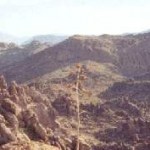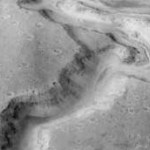sand
by Elizabeth Grossman
In response to results of the recently released National Institute for Occupational Safety and Health (NIOSH) field studies that found workers at hydraulic fracturing operations exposed to high levels of respirable crystalline silica, the Occupational Safety and Health Administration (OSHA) and NIOSH have issued a Hazard Alert. The alert outlines the health hazards associated with hydraulic fracturing and focuses specifically on exposures to airborne silica, saying that “employers must ensure that workers are properly protected from overexposure to silica.” It also…
by Elizabeth Grossman
“It’s basically strip mining,” said Wisconsin Department of Natural Resources (DNR) environmental engineer Rick Wulk, describing the sand mining activity that has exploded across western Wisconsin since 2010. Mining silica and quartz and processing it into industrial sand is big business these days because this sand is an important component of hydraulic fracturing operations that extract natural gas from shale. To understand the magnitude of the current boom in sand mining, the place to look is Wisconsin. What’s happening in Wisconsin also offers a good…
by Elizabeth Grossman
Tap water bursting into flame, water sources contaminated with toxic chemicals, once-pastoral rural hillsides turned over to industrial fossil fuel extraction, and unprecedented earthquake activity. These are among the environmental health concerns commonly associated with the extraction of natural gas by the method known as hydraulic fracturing – or fracking. But one of the more pernicious and pervasive potential occupational fracking hazards may come from sand. Not just ordinary sand, but sand that is nearly 100% crystalline silica and specially produced to play a key…
In a French laboratory, a team of ants is attempting a daring rescue. One of their colony-mates is trapped in a snare - a nylon thread that dastardly researchers have looped around its waist and half-buried in some sand. Thankfully, help is at hand. A crack squad of rescuers work together to dig away at the sand, expose the snare, and bite at the threads until their colleague is liberated.
Many animals help each other but actual rescue attempts, even between individuals of the same species, are rarely documented. Among back-boned animals, dolphins are famously said to help injured comrades…
An ant, climbing from the pit of a predatory ant lion.
The predator, buried in sand at the base of the pit, hurls a volley of debris towards its target.
Caught in the falling sand, the ant slides back into the pit.
The ant tries to escape, and again the unseen predator hurls a load of sand into her path.
No matter which way the ant turns, the ant lion adjusts its aim, sending up clouds of sand and preventing the ant from gaining traction on the steep walls of the pit.
In the end, the ant lion wins.
A tight crop of the previous image shows the jaws of the ant lion reaching up…
"You couldn't make this up: Cameras are being turned on the people paid to watch CCTV streams, to note which bits of surveillance footage they didn't see." via BoingBoing
The beauty of sand, close up -- a photo gallery at Discover.
Robots as recruitment to science. "If you stick a robot--I don't care if you're talking about grade school kids or high school students--if you put a robot in the middle of the room, there is something captivating about the technology." from Making Robots Personal - an interview with Tandy Trower of Microsoft Robotics. I find this particularly relevant as my 7-y.…
Eusattus dilatatus - dune darkling beetle (Tenebrionidae)
California, USA
Sand dunes are an unusual habitat, and the creatures found on them are equally odd. One of the more charismatic dune endemics is Eusattus dilatatus, a large darkling beetle found in southern California. This scavenging insect has long legs for digging and a waxy cuticle to prevent dessication.
Eusattus is not the easiest photographic subject. It seemed uncomfortable out in the open and would burrow as soon as I placed it on the sand. The series below spans 30 seconds.
**update** Tenebrionid expert Kojun Kanda…
Those of you who know me know that I'm unhappy living here in Arizona. The landscape and ecosystem of the Sonoran Desert, while beautiful to many, is too dry, rocky, and devoid of life for me to enjoy living here.
After my time here, I've decided that, were it somehow offered to me, I would probably pass on the opportunity to go to Mars. And so I present to you a little game I call "Mars or Arizona," where I will show you some pictures, and you get to guess which ones are pictures of Mars and which ones are pictures of Arizona. Sound easy?
Well let's bring on the pictures, and see if you…
People love to speculate that Mars was once a great place for life to form, and claim that there is plenty of evidence that there used to be oceans and rivers there. But this isn't true. People used to claim there were big Canal-like features on Mars, and used this as evidence that Mars was very wet.
It was later realized that these weren't canals, but rather geological features caused by impact craters from astroids. But more recently, people have been claiming that images like the one above are examples of dried-up riverbeds.
But this turns out not to be the case. When we take a closer…

